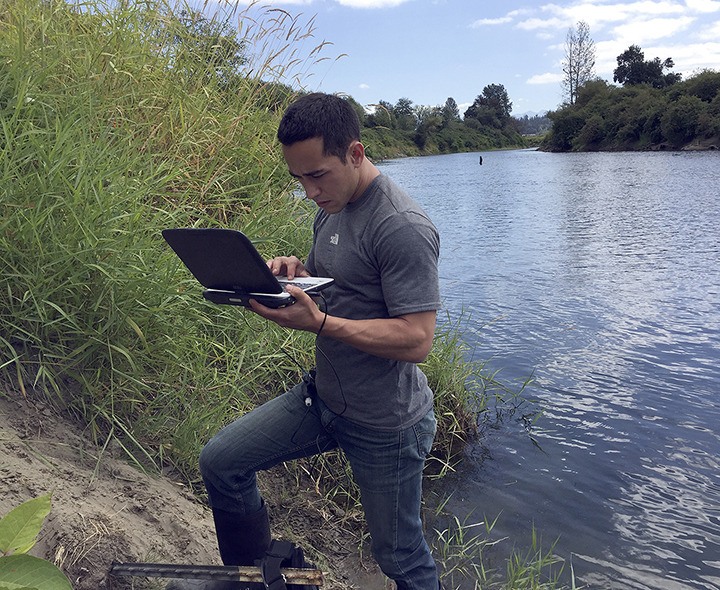By Joel Green
Contributing Writer
The summer of 2015 was a hard year for salmon in the Pacific Northwest, with thousands of returning sockeye salmon dying in the Columbia River due to warmer water. Fortunately, we didn’t have a die-off of adult salmon in the Snoqualmie River and its tributaries. However, the increased water temperatures and low flows were both bad news for the salmon, and probably led to delayed mortality of juvenile fish rearing in the river, and in some places inhibited adult salmon from swimming upstream to spawn.
“The Raging River hit an all-time low,” said Jennifer Whitney, District 13 Fish Biologist with the Washington Department of Fish and Wildlife. “That’s an important tributary for Chinook and steelhead. It didn’t get completely dry, but at the mouth of the river, the waters were so low that there was no access for Chinook when they first came back. It was a record low for that time of year.”
A combination of factors caused low flows and warm water. It was an uncommonly hot summer and lack of snow in the mountains the previous winter led to less snowmelt and low flows in the Snoqualmie and other rivers of the Pacific Northwest.
In the spring of 2015, scientists at the Snoqualmie Watershed Forum and King County saw an opportunity to investigate the effects of these extreme conditions on water temperature in the Snoqualmie River.
“We were motivated to gain a better understanding of temperature in an extreme year because of a couple reasons,” said Janne Kaje, Snoqualmie Salmon Recovery Manager with King County.
“First, this study could potentially inform our restoration planning and thinking. Second, based on what all the climate change models are telling us, these types of summers are likely to become much more prevalent in the future. This study helps us think about the long-term challenge for the fish and for all of us who are trying to address water quality, address habitat needs, and not lose these endangered populations.”
The scientists deployed thermistors that continuously measured water temperature at 27 locations along the Snoqualmie River and its major tributaries from June 30 to Sept. 30, 2015. After the summer, the scientists set to work analyzing all the data, and writing a comprehensive report.
So, what did they find out? During July and August, water temperatures were well above the healthy range for salmon during the hottest part of the day at most sample sites on most days. Daily maximum temperatures consistently above 17.5˚C (63.5˚F) are harmful to rearing and migrating salmon and trout.
The water temperature was highest in early July, up to a seven-day average maximum temperature of over 24˚C (75˚F) at several sites between Carnation and Duvall. Waters that warm can kill salmon, unless they find their way to cooler water in a tributary or deep pool.
Although the water cooled through July and August, it didn’t get down into the comfortable range for salmon until September.
Water got warmer as it flowed downstream, due to longer exposure to sunlight and increasing distance from snowmelt and cool springs in the mountains. However, inflows from tributaries had a cooling effect at some locations. The North Fork of the Snoqualmie was the coolest of the major tributaries, and the Middle Fork was the warmest.
Some of the smaller tributary creeks that were cooler than the mainstem Snoqualmie River included Harris Creek, Ames Creek, Tokul Creek, Griffin Creek, and Patterson Creek. These creeks mostly stayed below 18˚C (64˚F) during the summer, so they provided salmon with places to stay cool when the river was too warm. They were still warmer than optimal, but at least the salmon could live another day.
The report recommended several actions that could be taken to help keep the water cooler, and improve salmon habitat in the Snoqualmie River watershed:
• Headwater and tributary riparian (stream-side) restoration – We can ensure that tributary streams are well-shaded and thus cooled, by planting riparian trees and shrubs. As well as their potentially cooling influence on the mainstem rivers, the tributaries are also important in providing salmon with cool water to go to when the mainstem gets too hot.
• Instream flow augmentation or reduced withdrawals – By keeping more water in the river or in key tributaries, we could reduce the problem of low flows that allow the water to warm on hot days.
• Improved groundwater recharge – Allowing water from the surface of the ground to soak down and replenish the groundwater, for example by restoring wetlands, can increase the supply of cool groundwater that can seep into the streams and rivers in the summer.
• Improved hyporheic exchange – Allow for increased movement of water from the groundwater into the hyporheic zone (the soaked perimeter of streams and rivers where surface water mixes with groundwater). Where possible, removing levees and revetments (barriers to river flow, often in the form of angular rock) helps to improve hyporheic exchange. Because groundwater is cool, this movement of groundwater into the river helps to keep the river cool.
To see the full report, visit http://your.kingcounty.gov/dnrp/library/2016/kcr2750/kcr2750-txt.pdf.


